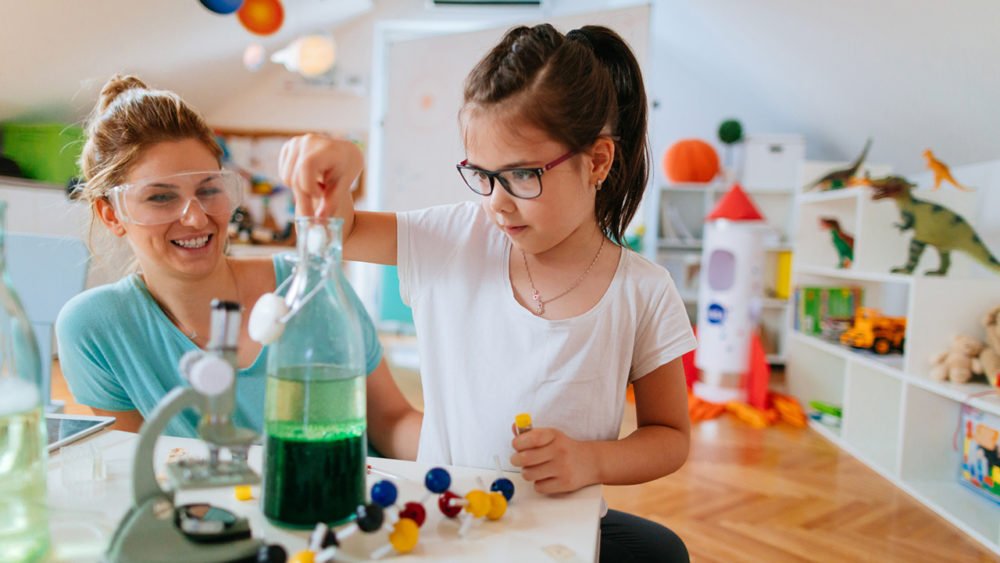Science is a world of discovery, and preschoolers are naturally curious about the world around them. By introducing simple science experiments, you can ignite their sense of wonder and teach fundamental concepts in a safe, fun, and hands-on way.
This article highlights preschool-friendly experiments that are easy to set up and safe for young learners. These activities use everyday materials and emphasize exploration and creativity over complex procedures.
Why Science Experiments Are Important for Preschoolers
- Encourages Curiosity: Experiments answer the “why” and “how” questions kids frequently ask.
- Develops Critical Thinking: Observing and hypothesizing help children build analytical skills.
- Promotes Hands-On Learning: Active participation ensures concepts are understood and remembered.
- Boosts Confidence: Completing simple tasks fosters independence and a sense of accomplishment.
Safe and Fun Preschool Science Experiments
1. Color Mixing Magic
- Materials Needed: Clear cups, water, food coloring (red, blue, yellow), and a spoon.
- What to Do: Fill cups with water and add a few drops of food coloring to each. Let children mix the colors (e.g., red + blue = purple).
- What They Learn: Primary colors combine to create secondary colors.
2. Baking Soda Volcano
- Materials Needed: Small plastic bottle, baking soda, vinegar, dish soap, and food coloring.
- What to Do: Fill the bottle halfway with vinegar, add a drop of dish soap and food coloring, and then add a spoonful of baking soda to watch the “eruption.”
- What They Learn: Chemical reactions (acid + base) produce gas.

3. Dancing Raisins
- Materials Needed: Clear soda (like sparkling water), raisins, and a clear glass.
- What to Do: Drop raisins into the soda and watch them rise and fall.
- What They Learn: Carbon dioxide bubbles attach to the raisins, causing them to float.
4. Magnet Play
- Materials Needed: Magnets and a variety of small objects (paper clips, coins, plastic toys).
- What to Do: Let children test which items are magnetic and which aren’t.
- What They Learn: Magnetic properties and material differences.
5. Ice Melting Race
- Materials Needed: Ice cubes, salt, and small bowls.
- What to Do: Place an ice cube in each bowl. Sprinkle salt on one and observe which melts faster.
- What They Learn: Salt lowers the freezing point of water, speeding up melting.
6. Floating and Sinking
- Materials Needed: A bowl of water and various small objects (toy cars, leaves, pebbles, etc.).
- What to Do: Let children guess which items will float or sink, then test their hypotheses.
- What They Learn: Buoyancy and density concepts.
7. Rainbow Celery Experiment
- Materials Needed: Celery stalks, glasses of water, and food coloring.
- What to Do: Add food coloring to glasses of water and place celery stalks inside. Watch as the color travels up the stalks over a few hours.
- What They Learn: Plants absorb water through capillary action.
8. Homemade Lava Lamp
- Materials Needed: Clear bottle, water, oil, food coloring, and an effervescent tablet.
- What to Do: Fill the bottle with water and oil, add food coloring, and drop in an effervescent tablet to create bubbles.
- What They Learn: Oil and water don’t mix, and the tablet releases gas, creating motion.
Tips for Safe Preschool Science Experiments
- Supervise at All Times: Even with safe materials, children should always be supervised during experiments.
- Use Non-Toxic Ingredients: Avoid harmful chemicals and opt for edible or household materials.
- Emphasize Fun Over Results: Encourage exploration, even if the experiment doesn’t go as planned.
- Involve Kids in Cleanup: Make tidying up part of the activity to teach responsibility.
Benefits of Introducing Science Early
- Foundation for Future Learning: Early exposure to science fosters an interest in STEM fields.
- Encourages Lifelong Curiosity: Kids learn to observe, question, and think critically.
- Strengthens Parent-Child Bond: Shared activities promote meaningful interaction.
Conclusion
Preschool science experiments offer a fantastic way to combine fun with learning. These safe, simple activities help children explore the world, develop important skills, and ignite their curiosity. Try these experiments at home or in the classroom to make science an exciting adventure for your little learners!










